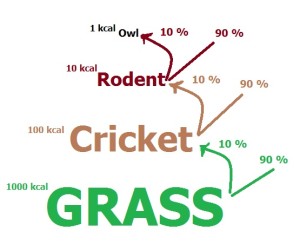Food for a growing population of humans
Today we have a large population of people who are starving or suffering from malnutrition. According to the food assistance branch of the UN, the World Food Program, 45% of deaths in children under the age of five is caused by poor nutrition. They also state that in the sub-Saharan Africa, which is the region with the highest prevalence of hunger, one in four people are undernourished
As we can see getting enough food for our large human population is already a problem – and it is only going to get worse. The human population is predicted to keep growing up to 9 billion (Godfray et al. 2010).
To understand some of the problems with choosing types of food for a larger human population we need to know a little bit about different trophic levels, which ScienceDaily defines as:
“In ecology, the trophic level is the position that an organism occupies in a food chain – what it eats, and what eats it.”ScienceDaily 11/02/16
In each trophic level the organism is using most of the energy for everyday processes, and that energy is ultimately lost for the ecosystem as respiratory heat. The energy that is not lost is used to build new biomass, which is called the production efficiency. Across all species the average production efficiency is 10 %, which means that the remaining 90 % is lost between each trophic level. These numbers differ between types of organism and especially with what kind of metabolism the organism has. The production efficiency can be anything from 1% to 50%.
Let’s look at one example. 10 % of the energy that the grasses produce during a lifetime is possible to transfer to the next trophic level: a cricket. The growth of the cricket biomass, which is only 10 % of the energy it got from the grass, will be the source of energy for a rodent. 10 % of that energy again will be accumulated in the biomass of the rodent, which the owl will be eating. So if you start out with 1000 kcal of grass, the owl at the top will only end up with 1 kcal of this.
This helps us to understand that if we use a lower trophic level as a source for food, we can get more food for more people and less energy is lost in the food chain.
By simulating the scenario that we eat less meat Stehfest et al. (2009) have found that we could reduce the amount of pasture area with 80 % compared to our dietary habits of today. This means that we could produce more food for more people, but decrease our use of land for food production. Stehfest et al. (2009) also points out that this could have a positive effect on the climate because these former crop-landscapes would capture carbon from the atmosphere as the vegetation grow back.
It looks like one of the ways that we can solve the problem of finding enough food for a growing human population is to reduce our consumption of meat. Are we willing to do that?
Written by: Ragnhild Gya
Sources:
Begon M., R.W. Howarth, C. R. Twonsend. (2014). The flux of energy and matter through
ecosystems. In: Essentials of Ecology. United States of America: Wiley. p 309-340.
Godfray H.C.J., J. R. Beddington, I.R. Crute, L. Haddad, D. Lawrence, J.F. Muir, J. Pretty, S.
Robinson, S. M. Thomas, C. Toulmin (2010) “Food: Security: The Challenge of
Feeding 9 Billion People”. Science. 327: 812-818
ScienceDaily. (2015). Trophic level. Available:
http://www.sciencedaily.com/terms/trophic_level.htm. Last accessed 11/02/16.
Stehfest E., L. Bouwman, D.P. van Vurren, M.G.J. den Elzen, B. Eickhout, P.Kabat (2009)
“Climate benefits of changing diet”. Climatic Change. 95:83-102
World Food Program. (2016). Hunger Statistics. Available: https://www.wfp.org/hunger/stats.
Last accessed 11/02/16.

The problem with feeding a growing population is one of the major challenges humanity faces. This is valid whether you are a neo-Malthusian or not, and it is an interesting topic. Reducing our meat consumption can of course be one way of freeing more resources for a future increasing population. Whether that population will be 9 billion (Godfray et al. 2010), 11.2 billion or 16.5 (UN 2015)
However, today the problem with malnutrition and hunger is not a question about recourses, but a question about distribution of the food we are already producing. If we distributed the food evenly to every single human being on the planet, each of us would daily get 2800 kcal (Smedshaug 2012 s. 31). Considering the UN operates with a recommended 2100 kcal per day (WPF 2016) we see where the problem is. This does not mean we will not come into trouble eventually. Particularly when thinking about population increase and decreasing food production in a globally less stable climate. With this in mind, feeding at a lower trophic level, reduction of waste and a change in diet might be inevitable.
Smedshaug C. A (2012) Kan jordbruket fø verden? 2 utg. Universitetsforlaget. Oslo
UN (2015) Department of economic and social affairs. Population Division. World population prospects 2015. Internet: http://esa.un.org/unpd/wpp/Graphs/Probabilistic/POP/TOT/ accessed [17.02.2016]
WFP (2016) What is hunger? Internet: http://www.wfp.org/hunger/what-is accessed [18.02.2016]
Great read, well done! And if you look into it, you’ll see that more and more people are choosing a more vegetarian-way of life! I personally think it would be great to do some kind of «5 a day» diet where one would eat vegetarian dishes 5 out of 7 days. It’s definitely possible, and by doing so reducing the meat consumption a lot without having to stop eating meat all together. I read somewhere that they call the last couple of years «the rise of the part-time vegetarians» – which is pretty accurate if you ask me:)